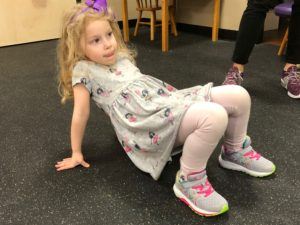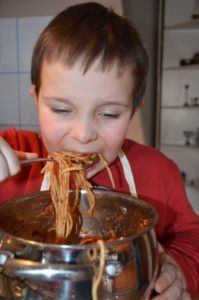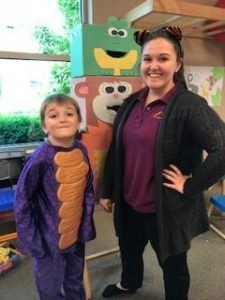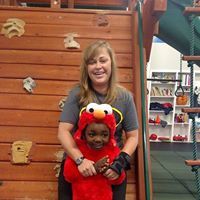Sensory
Holidays are a fun and exciting time of the year. Holidays can also be a stressful time of the year for both children and their parents. Children with deficits with sensory processing may have more difficulty with maintaining appropriate modulation which may lead to being overwhelmed and having more melt-downs. Keeping in mind the following strategies can help families get though the holiday season with less frustration.
· Put up Holiday decorations slowly over time. Allow your child to be part of the process of decorating so that she does not get overwhelmed with the lights, sounds, or changes in furniture set up.
· If you take your child shopping with you, try to avoid shopping at crowded or busy times. Shopping ahead of time or online might be appropriate alternatives.
· Educate extended family members about your child’s difficulties with sensory processing and let them know if there are any changes and adaptations that you will be making to traditional Holiday get togethers.
· When going to outings that may be overwhelming take your child’s comfort items and familiar toys for him to play with.
· Let your child know ahead of time what activities are scheduled. Let them know what the activity is, when it will take place, and what to expect. If possible, it may be beneficial to create a social story with pictures from previous years if possible to share with your child before an event.
· Try to stay on your normal routine: Try to be consistent with wake-up times, nap times, meal times, and bed times. Try to keep the same bedtime routine allowing time for your child to calm down before bed.

· Allow for extra rest and nap times if needed. Schedule in times for your child to have down time from scheduled activities in a quieter place.
· When going to family meals: allow for your child to eat at their typical meal time. Bring food that your child will usually eat and allow them to eat the familiar foods.
· When going to relatives/friends’ houses for get togethers it may be helpful to talk to the host a head of time to see if there is a separate place for your child to go to calm down if needed or to warm up to transition to environment.
· Dress your child in comfortable and familiar clothes. Allow the child to wear his favorite pants with a Holiday shirt, looks for clothes in the same fabric that they are used to wearing. For Holiday outfits, allow the child to wear the outfits before a holiday gathering.
· Be flexible on your expectations for traditional holiday activities. Allow for your child to stand near Santa or give him a high-5 instead of having your child sit on Santa’s lap for a photo. Let a child open only one or two gifts at a get-together and take the remaining gifts home to open at a later time.
Check out our video: Preparing your sensory child for a Holiday – YouTube
Staying flexible and making small adaptations can help you and your child have a more enjoyable Holiday season. For more information about sensory processing and development milestones please visit our website at: www.abcpediatrictherapy.com
Read MoreKids LOVE Halloween…between dressing up, the decorations, parties, and of course the candy…what’s not to love? But let’s be honest, Halloween is definitely not the most sensory friendly holiday. For kids with sensory processing disorder, it can be a literal nightmare. From the itchy costumes, flashing lights, loud noises, and unexpected scares, the night of Trick-or-Treat can be really overwhelming for you and your child. Below are 6 ways to have a sensory friendly Halloween this year!
- The costume…perhaps the most important step that you can control! Some costumes are scratchy, come with face paint that can be sticky or slimy, masks that smell funny, or other head pieces, that can just be painful for kids with sensory issues. Take your child with you to the store to feel the costume and gage their reaction when they touch the costume. That will give you a good idea if they’d be able to tolerate it for a whole evening or not. You could also have them wear some of their most comfortable clothes under their costumes. Or focus on using some of their own clothing to make a unique costume, keep it simple like a cowboy or a cat! When in doubt, do a trial run a few days before to ensure their comfort…you’ll appreciate it later when you have avoided a meltdown.

- Practice, practice, practice! Set-up time for you and your family to practice Halloween etiquette. First start with your own home, where things are most familiar. Work on ringing the door bell, what to say/how to respond, and how to take the candy…that way they know what to expect and can learn the routine. Next practice at a family or friends house, where things are familiar. It’s much easier to practice on a familiar face than a stranger.
- Plan your Trick-or- Treat route ahead of time. Try to Trick-or-Treat at neighbors who know you and your kids if possible. It is always easier to go to familiar places with familiar people. And you will also feel comfortable asking them questions like: what kind of decorations they have in their yard. Or they will not get offended if your kiddo is getting overstimulated and does not say “thank you” or respond appropriately to a question.
- P
 lan your time accordingly. Going Trick-or-Treating earlier in the night can be helpful, as it is often less crowded initially. Your child may benefit from a picture schedule, timer, or checklist so they know what to expect! Incorporating “break” times in which they can go back to the house or into your car, can help sensory overload. Be aware of your child’s warning signs that they might be getting overstimulated.
lan your time accordingly. Going Trick-or-Treating earlier in the night can be helpful, as it is often less crowded initially. Your child may benefit from a picture schedule, timer, or checklist so they know what to expect! Incorporating “break” times in which they can go back to the house or into your car, can help sensory overload. Be aware of your child’s warning signs that they might be getting overstimulated. - Go to smaller events…Trunk-or-Treats, mall, and/or church events are becoming increasingly popular, especially for parents who work, thus limiting the time families can go Trick-or-Treating. These events tend to be for kids of all ages, so it could limit the number of scary masks or decorations you encounter. This will greatly reduce the amount of transitions for you to navigate as well! These events can get crowded, so be sure to call ahead, to see what times tend to be less busy or how many people they are expecting.
 Make your own Halloween Traditions. When all is said and done, there is no rule saying you have to participate in any of these activities. If they are too much, it’s simply too much! Take it in stride and create your own Halloween traditions, by making it a pizza or game night, do
Make your own Halloween Traditions. When all is said and done, there is no rule saying you have to participate in any of these activities. If they are too much, it’s simply too much! Take it in stride and create your own Halloween traditions, by making it a pizza or game night, do  your child’s favorite activity, or have a special Mommy or Daddy only date every year to make the holiday special in another way.
your child’s favorite activity, or have a special Mommy or Daddy only date every year to make the holiday special in another way.
I hope these recommendations help you and your child have a happy and safe Halloween! Be sure to visit our website for other fun tips and information www.abcpediatrictherapy.com
Read MoreDid you know by 3 your child’s diet should typically consist of a variety foods with various textures, sights, temperatures, colors and consistencies? If your child is not eating a variety of fruits, vegetables, meats, and mixed foods (such as mac and cheese or spaghetti), then your child may be a picky eater.
Before addressing feeding, make sure you child’s sensory needs are being meet. Sometimes addressing sensory concerns, such as deficits in proprioceptive input (knowing where your body is in space through heavy work or deep pressure), vestibular input (movements such as swinging), and or tactile input (how your body reacts to touch) can be enough input to help your child try new foods.
Having your child jump on the trampoline or in place, wheelbarrow walk or any animal walk to the dinner table, and or swing prior to eating could be good activities to complete before meal time. Your child could also benefit from the brushing protocol to help with sensory input (contact an occupational therapist at ABC Pediatric Therapy for more information on this protocol). Also, make sure child is okay with getting messy. If s/he is not, it will be beneficial to address this first as well.
Using shaving cream is one of the easiest messy play activities. At first, make sure your child tolerates being in the same area as the shaving room. Once s/he tolerates being near the shaving cream, have your child begin interacting with it. Put cars, planes, or boats in it and have the child push these around without touching the shaving cream. Slowly begin introducing shaving cream onto the cars and see if your child will continue to touch the cars. Once they do, see if your child will imitate you drawing roads for these cars in the shaving cream. After your child tolerates interacting appropriately with the shaving cream your child is ready to begin trying new foods.
Dr. Kay Toomey developed a feeding hierarchy that has been proven to have great success is regards to sensory picky eaters. Following along the same lines as shaving cream play, Dr. Toomey wants children to be able to tolerate and interact with new foods before actually eating them. If they are not able to tolerate being at the table with the food, then they are not going to be able to interact with it.
To assist with interacting with food, have your child prepare food and use utensils or the container to stir or pour foods/drinks. If your child is having difficulty with using utensils and self-feeding skills, please contact an occupational therapist for additional assistance.
Once your child interacts with foods, the next step on the hierarchy is to smell the foods; have your child lean down or pick it up to smell the food. The next big step is touching foods; go from touching it to his/her fingers to whole hand to chin/nose to lips to teeth to tip of tongue to full tongue to licking it. At this point, reward your child with a preferred food after 1-3 consecutive touches or licks of a non-preferred food. After your child is licking new foods, the next step is to begin tasting them. Initially have him/her take a small bite and designate a spit out jar. Once s/he is able to do this, see if your child can hold the food in his/her mouth for a certain amount of time or even chewing a certain amount of times before spitting out. The next goal would be to chew and swallow with a drink and then independently. Also, at this point, begin rewarding your child with a preferred food after so many bites of a non-preferred food. For example, have your child take 2 small bites of a green bean before being rewarded a preferred gold fish and then repeat this until you are satisfied with how many bites of a non preferred food your child is eating in one sitting.
If your child is not making the progress you want, your child may have oral motor deficits. For example, if your child is only eating softer, blander foods, they may have decreased strength. They may also have an immature chew which could make feeding difficult. An occupational therapist would also be able to assess this. A therapist will also be able to determine if your child is having sensitivities to the temperature, texture, flavor, sight, or smell of certain foods which could be inhibiting his/her success.
Please contact ABC Pediatric Therapy for more ideas geared towards your specific needs and if you have any additional questions. Visit our website at www.abcpediatrictherapy.com to find the location nearest you.
Read More Skip to content
Skip to content



 lan your time accordingly. Going Trick-or-Treating earlier in the night can be helpful, as it is often less crowded initially. Your child may benefit from a picture schedule, timer, or checklist so they know what to expect! Incorporating “break” times in which they can go back to the house or into your car, can help sensory overload. Be aware of your child’s warning signs that they might be getting overstimulated.
lan your time accordingly. Going Trick-or-Treating earlier in the night can be helpful, as it is often less crowded initially. Your child may benefit from a picture schedule, timer, or checklist so they know what to expect! Incorporating “break” times in which they can go back to the house or into your car, can help sensory overload. Be aware of your child’s warning signs that they might be getting overstimulated. Make your own Halloween Traditions. When all is said and done, there is no rule saying you have to participate in any of these activities. If they are too much, it’s simply too much! Take it in stride and create your own Halloween traditions, by making it a pizza or game night, do
Make your own Halloween Traditions. When all is said and done, there is no rule saying you have to participate in any of these activities. If they are too much, it’s simply too much! Take it in stride and create your own Halloween traditions, by making it a pizza or game night, do  your child’s favorite activity, or have a special Mommy or Daddy only date every year to make the holiday special in another way.
your child’s favorite activity, or have a special Mommy or Daddy only date every year to make the holiday special in another way.